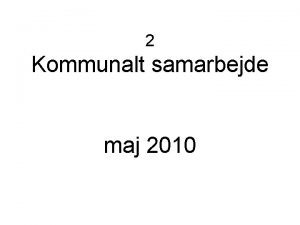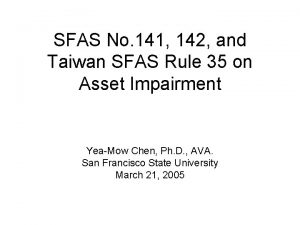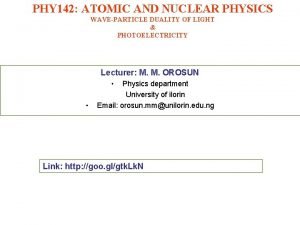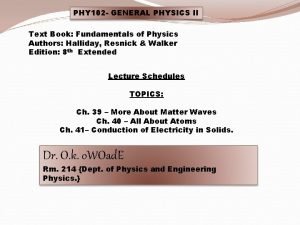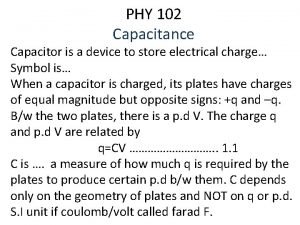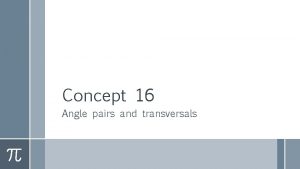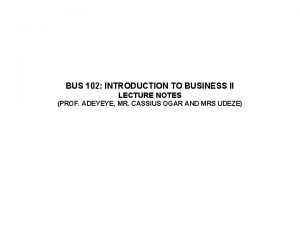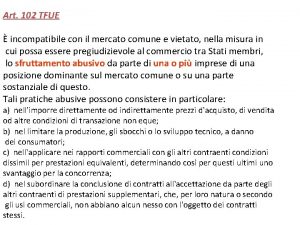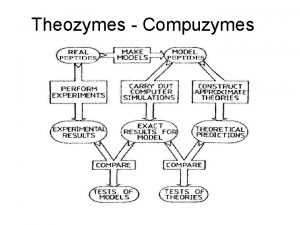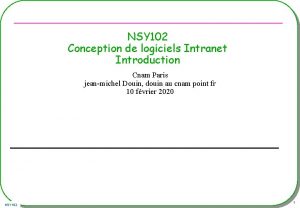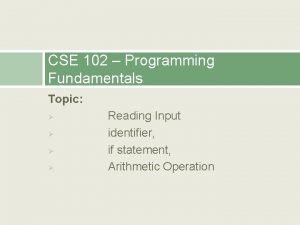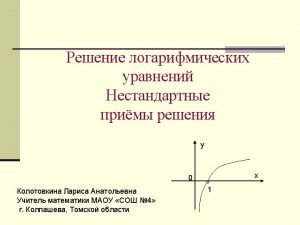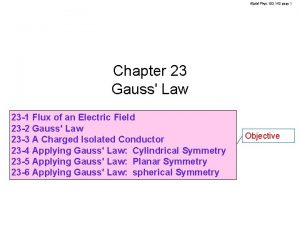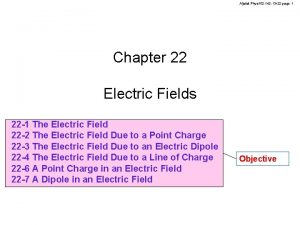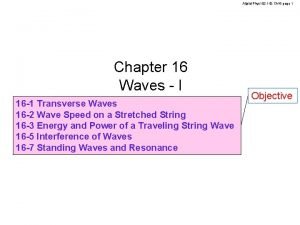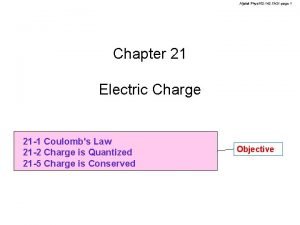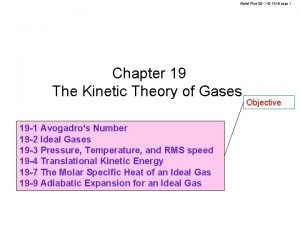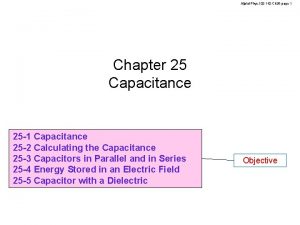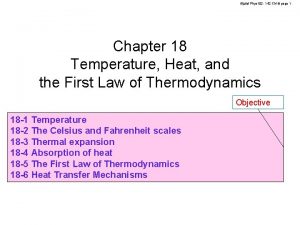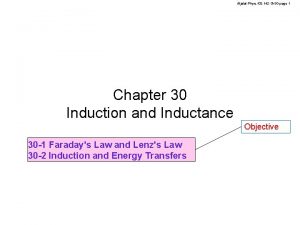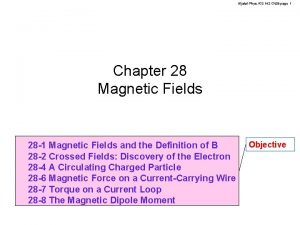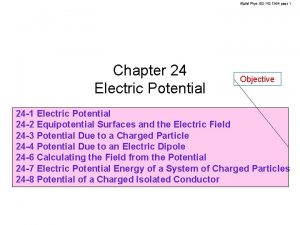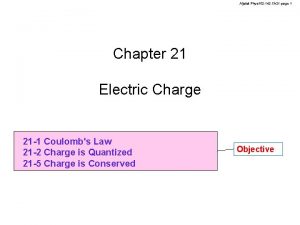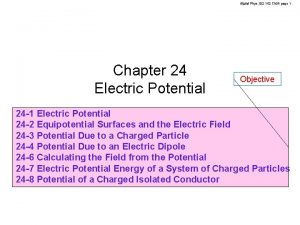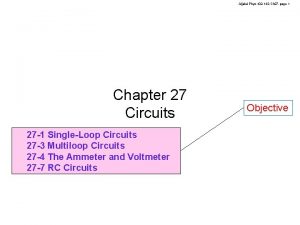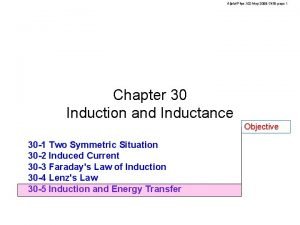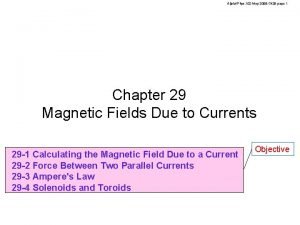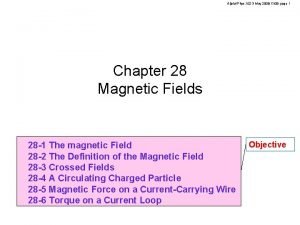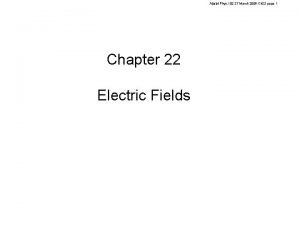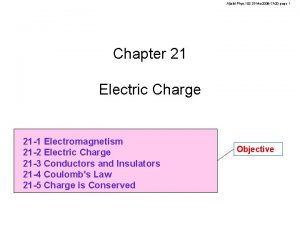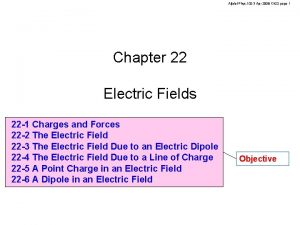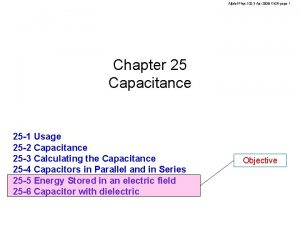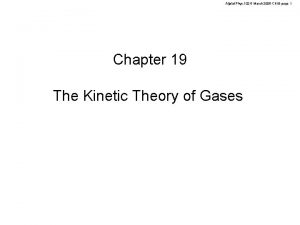AljalalPhys 102 142 Ch 24 page 1 Chapter



























































- Slides: 59

Aljalal-Phys. 102 -142 -Ch 24 -page 1 Chapter 24 Electric Potential Objective 24 -1 Electric Potential 24 -2 Equipotential Surfaces and the Electric Field 24 -3 Potential Due to a Charged Particle 24 -4 Potential Due to an Electric Dipole 24 -6 Calculating the Field from the Potential 24 -7 Electric Potential Energy of a System of Charged Particles 24 -8 Potential of a Charged Isolated Conductor

Aljalal-Phys. 102 -142 -Ch 24 -page 2 24 -1 Electric Potential Conservative force Electrostatic force is a conservative force. We can define a electric potential energy to a system of charged particles. DU = - W Change in electric potential energy work done by the electrostatic force on the particles

24 -1 Electric Potential Work done by conservative force is path independent Aljalal-Phys. 102 -142 -Ch 24 -page 3 Electrostatic force is a conservative force. DU = - W Work done by the electrostatic force on charged particles is independent of path. q 3 q 2 Path B q 3 q 2 q 1 Path A q 1 Initial state Final state Work done by the electrostatic force on charged particles depends only on the state of the system.

24 -1 Electric Potential Zero potential energy configuration Aljalal-Phys. 102 -142 -Ch 24 -page 4 Only differences in potential energy have physical meaning. DU = Uf - Ui = - W We are free to define zero potential energy configuration. We may choose our reference configuration when the particles are all infinitely separated from each other. U∞= 0 when all particles at infinity U = - W∞ Electric potential energy of any charged particles configuration Work done by the electrostatic force to bring the charged particles from infinity

Aljalal-Phys. 102 -142 -Ch 24 -page 5 24 -1 Electric Potential Example 1 An electron in a uniform electric field E = 150 N/m Displacement d = 520 m -e d What is the change in the electric potential energy of the electron? -e Initial state Solution small displacement vector points towards the final position Final state The electric potential energy of the electron decreases.

Aljalal-Phys. 102 -142 -Ch 24 -page 6 24 -1 Electric Potential Checkpoint 1 p Uniform electric field d p Does the electric field do positive or negative work on the proton? Initial state Solution Final state Negative work Does the electric potential energy of the proton increase or decrease? Solution The electric potential energy of the proton increases.

24 -1 Electric Potential Electric potential energy depends on the charge Aljalal-Phys. 102 -142 -Ch 24 -page 7 final position Initial position q Path The change in the electric potential energy depends on the charge as well as on the electric field.

24 -1 Electric Potential Electric potential difference Electric potential Aljalal-Phys. 102 -142 -Ch 24 -page 8 Electric potential energy Electric potential difference The electric potential difference DV is the difference in the electric potential energy DU per unit charge.

Aljalal-Phys. 102 -142 -Ch 24 -page 9 24 -1 Electric Potential Electric potential difference does not depend on the charge final position Initial position q Path Electric potential difference does not depend on the charge. Electric potential difference depends only on the electric field. Electric potential is a property of the electric field.

24 -1 Electric Potential Electric potential and work Aljalal-Phys. 102 -142 -Ch 24 -page 10 If we choose U∞= 0 when all particles at infinity, the electric potential at any point in an electric field will be Work done by the electrostatic field on a charged particle as that particle moves in from infinity to the point

24 -1 Electric Potential Volt is the SI unit for the electric potential Electric potential is measured in volts Aljalal-Phys. 102 -142 -Ch 24 -page 11

Aljalal-Phys. 102 -142 -Ch 24 -page 12 24 -1 Electric Potential SI Units for the electric field Electric field is measured in newton/coulomb N/C or volt/meter V/m

Aljalal-Phys. 102 -142 -Ch 24 -page 13 24 -1 Electric Potential Electron-volt Energy is measured in Joule J or Electron-volt e. V One electron-volt is equal to the energy gained by an electron when it moves through a potential difference of one volt. DV = 1 Volt Initial -e At rest DV = 1 Volt -e Final Energy = 1 e. V

Aljalal-Phys. 102 -142 -Ch 24 -page 14 24 -1 Electric Potential Work-kinetic energy theorem q final position q Initial position Path Electric field lines Work-kinetic energy theorem Change in the kinetic energy of the particle Kf - Ki Work done by the applied forces Work done by the field - DU

Aljalal-Phys. 102 -142 -Ch 24 -page 15 24 -1 Electric Potential Conservation of mechanical energy q final position q Initial position Path Electric field lines Ignore gravitational force If the kinetic energy of the particle does not change Kf = Ki, 0 = Wapp + W Wapp = - W = - (-DU) Wapp= DU Wapp= q. DV If the applied force on the particle is zero Fapp= 0, DK = 0 + W DK = 0 - DU DK + DU = 0 Conservation of mechanical energy

24 -2 Equipotential Surfaces and the Electric Field Definition Aljalal-Phys. 102 -142 -Ch 24 -page 16 All points on an equipotential surface have the same electric potential. 20 V 15 V Equipotential surface

24 -2 Equipotential Surfaces and the Electric Field Start and end at the same equipotential surface Aljalal-Phys. 102 -142 -Ch 24 -page 17 Path B 24 V f i Path A f i equipotential surface DV = 0 When a charge particle moves between two points on the same equipotential surface, no net work is done on it by the field.

24 -2 Equipotential Surfaces and the Electric Field Start and end at different equipotential surfaces 15 V i Path A i Path B Aljalal-Phys. 102 -142 -Ch 24 -page 18 f f 5 V Equipotential surfaces The same work is done by the field on a charged particle over any path connecting two equipotential surfaces.

24 -2 Equipotential Surfaces and the Electric Field Equipotential surfaces are normal to electric field Equipotential surfaces are always perpendicular to the electric field lines Electric field line 900 Equipotential surface Aljalal-Phys. 102 -142 -Ch 24 -page 19

Aljalal-Phys. 102 -142 -Ch 24 -page 20 24 -2 Equipotential Surfaces and the Electric Field Why are equipotential surfaces normal to electric field? Equipotential surface DV = 0 Electric field line To satisfy this on any path on the equipotential surface, i 900 f Equipotential surface

24 -2 Equipotential Surfaces and the Electric Field Uniform electric field Aljalal-Phys. 102 -142 -Ch 24 -page 21 Equipotential surfaces for a uniform electric field are planes Lower electric potential higher electric potential i Equipotential surfaces = planes (cross section) DS f Electric field lines Electric fields point toward lower electric potential values.

24 -2 Equipotential Surfaces and the Electric Field Point charge Aljalal-Phys. 102 -142 -Ch 24 -page 22 Equipotential surfaces for a point charge are spheres q Equipotential surfaces = spheres (cross section) Electric field lines

24 -2 Equipotential Surfaces and the Electric Field Electric dipole Aljalal-Phys. 102 -142 -Ch 24 -page 23 Equipotential surfaces for an electric dipole Equipotential surfaces (cross section) Electric field lines

24 -2 Equipotential Surfaces and the Electric Field Formula Aljalal-Phys. 102 -142 -Ch 24 -page 24 If the electric field is known, the electric potential difference can be found from Line integral (integral over a particular path) Any path will produce the same result Path B Initial position i Path A f Differential displacement points toward the final position Electric field lines

Aljalal-Phys. 102 -142 -Ch 24 -page 25 24 -2 Equipotential Surfaces and the Electric Field A reference point If we choose Vi = 0 at point i, we can write the electric potential at any point relative to zero potential at point i as The electric potential at point f relative to zero potential at point i Reference point V = 0 f i Initial position final position

24 -2 Equipotential Surfaces and the Electric Field Checkpoint 3 We will move an electron along these lines Aljalal-Phys. 102 -142 -Ch 24 -page 26 1 2 3 5 4 90 V 80 V 70 V 60 V 50 V 40 V What is the direction of the electric field? What is the work we do for each path? (the electron is at rest at the initial and final points) Solution Electric fields point toward lower electric potential values. 3 Wapp = (-e)(-20)=20 e 1 Wapp = (-e)(-10)=10 e 4 Wapp = (-e)(10)= -10 e 2 Wapp = (-e)(-10)=10 e 5 Wapp = (-e)(-10)= 10 e

Aljalal-Phys. 102 -142 -Ch 24 -page 27 24 -2 Equipotential Surfaces and the Electric Field Example 2 d Find the electric potential difference between i and f by using path A and B c th Pa d B Path A Solution i Path A f Path B From i to c From c to f Same

24 -3 Potential Due to a Charged Particle Formula Aljalal-Phys. 102 -142 -Ch 24 -page 28 The electric potential due to a particle of charge q at distance r form the particle P q r Reference V = 0 when r = ∞

24 -3 Potential Due to a Charged Particle Sign of the electric potential due to a point charge A positively charged particle produces a positive electric potential A negatively charged particle produces a negative electric potential Aljalal-Phys. 102 -142 -Ch 24 -page 29

24 -3 Potential Due to a Charged Particle Proof - electric potential due to a point charge Aljalal-Phys. 102 -142 -Ch 24 -page 30 f at infinity Choose Vf = 0 at infinity and call Vi = V Derivation of Choose a path along the radial direction that starts a point ri from the charge and end at infinity q Pa th i ri If the symbol ri is changed to r

24 -3 Potential Due to a Charged Particle Outside spherically symmetric charge distribution Aljalal-Phys. 102 -142 -Ch 24 -page 31 Electric potential outside a spherically symmetric charge distribution of radius R and with total charge q Outside r > R R Electric Field Outside, the electric field is similar to that of a point charge q placed at the center. Electric potential The symbol ri has been changed to r Similar to the electric potential due to a point charge q placed at the center of the sphere R r

24 -3 Potential Due to a Charged Particle Inside spherically symmetric charge distribution Aljalal-Phys. 102 -142 -Ch 24 -page 32 Electric potential inside a spherically symmetric charge distribution of radius R and with total charge q Inside r < R R Electric Field inside outside Constant The electric potential inside a spherically symmetric charge distribution is constant. Electric potential R r

24 -3 Potential Due to a Charged Particle Superposition q 2 Aljalal-Phys. 102 -142 -Ch 24 -page 33 q 3 r 2 q 1 r 3 r 1 P Superposition Total electric potential V at point P is the algebraic sum of the electric potential at point P from each point charge

24 -3 Potential Due to a Charged Particle Difference between electric field and electric potential q 2 Aljalal-Phys. 102 -142 -Ch 24 -page 34 q 3 r 2 q 1 r 3 r 1 P Vector Scalar Vector sum Algebraic sum Difficult Easy

24 -3 Potential Due to a Charged Particle Formula q 2 Aljalal-Phys. 102 -142 -Ch 24 -page 35 q 3 r 2 q 1 r 3 r 1 Distance from P to q 3 For 3 charged particles For n charged particles

Aljalal-Phys. 102 -142 -Ch 24 -page 36 24 -3 Potential Due to a Charged Particle Checkpoint 4 d Rank the net electric potential at P, greatest first. D q 2 q 1 P d q 1 Solution D q 2 P All tie D q 2 P d q 1

Aljalal-Phys. 102 -142 -Ch 24 -page 37 24 -3 Potential Due to a Charged Particle Example 3 d =1. 3 m q 1= +12 n. C q 1 d P r q 2= -24 n. C q 3= +31 n. C q 4= +17 n. C q 3 What is the electric potential at point P? Solution q 2 d d d q 4

Aljalal-Phys. 102 -142 -Ch 24 -page 38 24 -3 Potential Due to a Charged Particle Example 4 12 electrons are equally spaced on a circle of radius R What is the electric potential at the center C? -e Solution -e -e c E = 0 e -- -e -e -e Solution -e R -e What is the electric field at the center C? -e -e -e

Aljalal-Phys. 102 -142 -Ch 24 -page 39 24 -3 Potential Due to a Charged Particle Example 5 12 electrons on a circle of radius R What is the electric potential at the center C? -e -e Solution R -e -e C -e -e What is the electric field at the center C? Solution -e -e

Aljalal-Phys. 102 -142 -Ch 24 -page 40 24 -4 Potential Due to an Electric Dipole Formula For r >> d The electric potential of an electric dipole The angle between the dipole moment vector and the line extending from the dipole midpoint to the point of measurement P The distance form the electric dipole d O

Aljalal-Phys. 102 -142 -Ch 24 -page 41 24 -4 Potential Due to an Electric Dipole Checkpoint 4 Rank points a, b, and c according to the electric potential of the dipole there, greatest (most positive) first. r >> d. a Solution c At point a 1 At point b 3 At point c 2 b

Aljalal-Phys. 102 -142 -Ch 24 -page 42 24 -6 Calculating the Field from the Potential Formula - Electric field component along any direction If you know the electric potential V, you can calculate the component of the electric field along direction s, from s Partial derivative Treat all variables except s variable as constants Equipotential surfaces (cross section) The component of the electric field in any direction is the negative of the rate of change of the electric potential with distance in that direction.

Aljalal-Phys. 102 -142 -Ch 24 -page 43 24 -6 Calculating the Field from the Potential Formula - Electric field component along x, y, and z directions The component of the electric field along x-axis Treat y and z variables as constants The component of the electric field along y-axis Treat x and z variables as constants The component of the electric field along z-axis Treat x and y variables as constants

24 -6 Calculating the Field from the Potential Example 5 Aljalal-Phys. 102 -142 -Ch 24 -page 44 Find the electric field associated with the following electric potential Solution

24 -6 Calculating the Field from the Potential Uniform electric field Aljalal-Phys. 102 -142 -Ch 24 -page 45 For uniform electric field, the equipotential surfaces are equally spaced Equipotential surfaces are equally spaced 40 V 50 V 60 V 70 V 900 s 1 V 1 s 2 V 2 s

24 -6 Calculating the Field from the Potential Uniform electric field along x-axis Aljalal-Phys. 102 -142 -Ch 24 -page 46 For uniform electric field, the equipotential surfaces are equally spaced 40 V 50 V 60 V 0 2 Equipotential surfaces are equally spaced 70 V 4 Always, electric fields point toward lower electric potential values. x (cm)

Aljalal-Phys. 102 -142 -Ch 24 -page 47 24 -6 Calculating the Field from the Potential Checkpoint 5 Rank the magnitude of the electric field between the plates d d d x - 50 V +150 V - 20 V +200 V -400 V Solution Tie Largest Tie

24 -6 Calculating the Field from the Potential Checkpoint 5 Aljalal-Phys. 102 -142 -Ch 24 -page 48 What happens to an electron between the plates? -e - 200 V -400 V Solution -e - 200 V The electron accelerates to the left. -400 V

24 -6 Calculating the Field from the Potential Proof - Electric field component along any direction Aljalal-Phys. 102 -142 -Ch 24 -page 49 Deviation of If Ds is very small such the electric field does not change much over Ds s q Equipotential surfaces (cross section)

24 -6 Calculating the Field from the Potential Calculating electric field and electric potential Aljalal-Phys. 102 -142 -Ch 24 -page 50 You know V You want E You know E You want DV Special case Uniform E q is the angle between E and ds q

Aljalal-Phys. 102 -142 -Ch 24 -page 51 24 -7 Electric Potential Energy of a System of Charged Particles Electric potential energy and the applied work q 2 q 3 q 1 What is the electric potential energy of these fixed point charges? Work done by the field Assume these point charges were stationary at infinity and we brought them to this fixed configuration. We will choose our reference U∞= 0 Work we do to bring the charges from infinity to this configuration

Aljalal-Phys. 102 -142 -Ch 24 -page 52 24 -7 Electric Potential Energy of a System of Charged Particles Electric potential energy = applied work to assemble the system q 2 q 3 q 1 What is the electric potential energy of these fixed point charges? The electric potential energy of a system of fixed point charges is equal to the work that must be done by an external agent to assemble the system by bringing each point from an infinite distance.

Aljalal-Phys. 102 -142 -Ch 24 -page 53 24 -7 Electric Potential Energy of a System of Charged Particles Assembling two point charges q 2 r 12 q 1 What is the electric potential energy of these fixed point charges? First, we will bring q 1 from infinity Since there is no external field q 1 q 2 r 12 Second, we will bring q 2 from infinity q 1 It will move in the electric field of q 1

Aljalal-Phys. 102 -142 -Ch 24 -page 54 24 -7 Electric Potential Energy of a System of Charged Particles Assembling three point charges What is the electric potential energy of these fixed point charges? q 3 r 23 r 13 q 2 q 1 r 12 q 3 r 23 r 13 q 2 r 12 q 1 We know that we need to do work of U 12 to bring q 1 and q 2 at this position Next, we will bring q 3 from infinity It will move in the electric field of q 1 and q 2

Aljalal-Phys. 102 -142 -Ch 24 -page 55 24 -7 Electric Potential Energy of a System of Charged Particles Formula q 3 q 2 U = q 4 What is the electric potential energy of these fixed point charges? q 1 + 0 + U 12 + U 13 + U 23 + U 14 + U 24 + U 34 Applied work to bring 1 st charge from ∞ Applied work to bring 2 nd charge from ∞ Applied work to bring 3 rd charge from ∞ Applied work to bring 4 th charge from ∞ Distance between qi and qj The total potential energy of a system of particles is the sum of the potential energies for every pair of particles in the system.

Aljalal-Phys. 102 -142 -Ch 24 -page 56 24 -7 Electric Potential Energy of a System of Charged Particles Example 6 d = 12 cm q 2 q =150 n. C q 1 =+q q 2 = -4 q q 3 = +2 q d d What is the electric potential energy of the system? q 1 q 3 d Solution U = U 12+ U 13 + U 23 You have to do a work of – 17 m. J to assemble this structure from points at infinity Or You have to do a work of + 17 m. J to dissemble this structure to points at infinity

24 -9 Potential of a Charged Isolated Conductor Electric potential within a conductor Aljalal-Phys. 102 -142 -Ch 24 -page 57 In electrostatic equilibrium, all points within a conductor have the same potential Conductor E =0 f i

24 -9 Potential of a Charged Isolated Conductor Electric potential of an isolated spherical conductor Aljalal-Phys. 102 -142 -Ch 24 -page 58 Spherical isolated conductor Total charge q R Electric Field Electric potential R r

24 -9 Potential of a Charged Isolated Conductor Isolated conductor in an external electric Aljalal-Phys. 102 -142 -Ch 24 -page 59 Surface of conductor is an equipotential surface External electric field Conductor E =0 Electrons distribute themselves on the surface such that E= 0 inside the conductor and electric field is perpendicular to the surface of the conductor.
 Apa format tittle page
Apa format tittle page Prime number 107
Prime number 107 Pl 94 142
Pl 94 142 Pl-94-142
Pl-94-142 Signos romanos
Signos romanos Cs142 stanford
Cs142 stanford Saddest psalms
Saddest psalms Mat 142
Mat 142 5600 in scientific notation
5600 in scientific notation Phm 142
Phm 142 Java critter strategy
Java critter strategy Læ 145 fleksjob
Læ 145 fleksjob Stanford cs 142
Stanford cs 142 Convenio 142 oit
Convenio 142 oit Intangible inputs
Intangible inputs Sfas 142
Sfas 142 Physics 142
Physics 142 Dicom supplement 142
Dicom supplement 142 Phys 142
Phys 142 12 742 km in miles
12 742 km in miles 142 cooper river drive
142 cooper river drive 100000/142
100000/142 Fitness chapter 102
Fitness chapter 102 Physics 102 electricity and magnetism
Physics 102 electricity and magnetism Uiuc physics 102
Uiuc physics 102 Changamoto za fasihi andishi
Changamoto za fasihi andishi Servicelovens 102
Servicelovens 102 Convenio 102 norma minima de seguridad social
Convenio 102 norma minima de seguridad social Psalm 28 niv
Psalm 28 niv Psalm 102 25
Psalm 102 25 Physics 102
Physics 102 102 capacitor
102 capacitor Nur 102
Nur 102 Met 102
Met 102 Data 102
Data 102 Csc102
Csc102 Alternate exter angles
Alternate exter angles Convenio 102
Convenio 102 Bus 102
Bus 102 Articolo 102 tfue
Articolo 102 tfue 657 102 madde
657 102 madde Tc 7-102
Tc 7-102 Asp 102
Asp 102 I 102 104
I 102 104 Physics 102 final exam
Physics 102 final exam In the figure m 3=102
In the figure m 3=102 Jmx 102
Jmx 102 Human biology ucsd
Human biology ucsd Redstone oscillator
Redstone oscillator Cse102
Cse102 Làm thế nào để 102-1=99
Làm thế nào để 102-1=99 Sinak s102
Sinak s102 35 usc 102
35 usc 102 Lgx=5
Lgx=5 Sfu iat 102
Sfu iat 102 Iat 102
Iat 102 Iat 102
Iat 102 Kmvss article 95
Kmvss article 95 Iho s-102
Iho s-102 George carlin age
George carlin age











